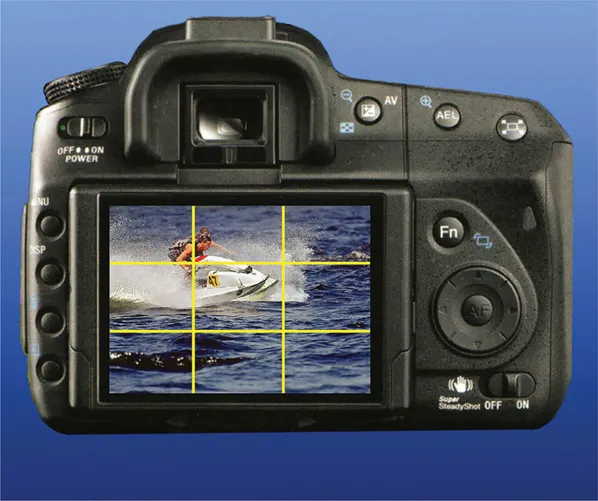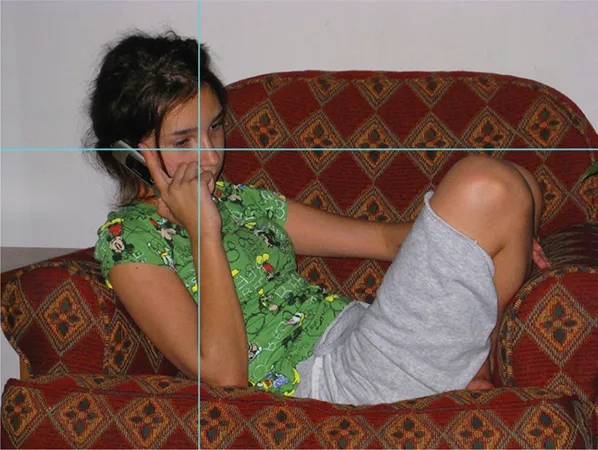
eBook - ePub
Photographic Composition
A Visual Guide
Richard D. Zakia
This is a test
Condividi libro
- 304 pagine
- English
- ePUB (disponibile sull'app)
- Disponibile su iOS e Android
eBook - ePub
Photographic Composition
A Visual Guide
Richard D. Zakia
Dettagli del libro
Anteprima del libro
Indice dei contenuti
Citazioni
Informazioni sul libro
"Those of you who follow this blog know that Dr. Richard Zakia, former RIT professor, is one of my all time favorite photo gurus. We send each other pictures. We talk about looking into pictures - and not just looking at them. Big difference.. Dr. Richard Zakia, a.k.a. Dick, is the co-author, along with David Page, of Photographic Composition: A Visual Guide. These two dudes are also two of my favorite people."---Rick Sammon's blog
"Covers all the tips needed to help photographers construct their own unique, outstanding images and is an outstanding 'must' for any collection."--CA Bookwatch
Domande frequenti
Come faccio ad annullare l'abbonamento?
È semplicissimo: basta accedere alla sezione Account nelle Impostazioni e cliccare su "Annulla abbonamento". Dopo la cancellazione, l'abbonamento rimarrà attivo per il periodo rimanente già pagato. Per maggiori informazioni, clicca qui
È possibile scaricare libri? Se sì, come?
Al momento è possibile scaricare tramite l'app tutti i nostri libri ePub mobile-friendly. Anche la maggior parte dei nostri PDF è scaricabile e stiamo lavorando per rendere disponibile quanto prima il download di tutti gli altri file. Per maggiori informazioni, clicca qui
Che differenza c'è tra i piani?
Entrambi i piani ti danno accesso illimitato alla libreria e a tutte le funzionalità di Perlego. Le uniche differenze sono il prezzo e il periodo di abbonamento: con il piano annuale risparmierai circa il 30% rispetto a 12 rate con quello mensile.
Cos'è Perlego?
Perlego è un servizio di abbonamento a testi accademici, che ti permette di accedere a un'intera libreria online a un prezzo inferiore rispetto a quello che pagheresti per acquistare un singolo libro al mese. Con oltre 1 milione di testi suddivisi in più di 1.000 categorie, troverai sicuramente ciò che fa per te! Per maggiori informazioni, clicca qui.
Perlego supporta la sintesi vocale?
Cerca l'icona Sintesi vocale nel prossimo libro che leggerai per verificare se è possibile riprodurre l'audio. Questo strumento permette di leggere il testo a voce alta, evidenziandolo man mano che la lettura procede. Puoi aumentare o diminuire la velocità della sintesi vocale, oppure sospendere la riproduzione. Per maggiori informazioni, clicca qui.
Photographic Composition è disponibile online in formato PDF/ePub?
Sì, puoi accedere a Photographic Composition di Richard D. Zakia in formato PDF e/o ePub, così come ad altri libri molto apprezzati nelle sezioni relative a Media & Performing Arts e Digital Media. Scopri oltre 1 milione di libri disponibili nel nostro catalogo.
Informazioni
1
Before Capture
It is helpful to give some thought to what you want to photograph before going out to do so. Both physical and mental planning are important when preparing to photograph.
Physical Preparation: Besides preparing the needed equipment such as cameras, lenses, filters, and the like, thought must be given to what you intend to photograph: nonaction (landscapes, flowers, portraits, antique cars) or action (sports, kids at play, motion). For example, in photographing a person, many a fine portrait has been diminished because the person to be photographed got bored waiting for the photographer to get ready, which includes such things as selecting the background, type of lighting, camera lens, and filter. All preparation should be taken care of before the person is positioned to ensure the desired result. The first few seconds of a portrait session are golden. Relax your subject. Some photographers play music in the background to help relax the person.
Rick Sammon, author of many books on photography, has his own method for relaxing people before photographing them. He spends time with them before photographing, engaging them in conversation, telling jokes, and performing some magic tricks to entertain. It has worked well for him.
When Vicki Wilson decided to do a Vermeer-like photograph (subject bathed in soft window light), she planned well ahead by first reviewing the many Vermeer paintings on the Internet. She and Missy discussed the location, props, wardrobe, and what Missy would be doing (implied action) while being photographed. (See page 197) A two-hour block of time was reserved for completing the assignment.
When photographing a landscape, time of day becomes important, because it will determine the direction and quality of light available (bright sun, cloudy, hazy). Realize that even with planning, atmospheric conditions might change. Don’t overlook the opportunity to capture the unexpected. It is amazing how photographing in a mist or during and after a rain can add mood and substance to the image. When Ansel Adams photographed landscapes, he always attended to the sky to make sure no birds were in flight, as they would be recorded as white specs of dust on the negative and black specs on the print.
Roy Stryker, who headed up the important photographic operation of the Farm Security Administration (FSA) in 1939, would make specific assignments for his photographers. In his “General Notes for Pictures Needed for Files” he would list such things as small towns, signs, farms, industry, people, and so on. Photographers such as Dorothea Lange, Russell Lee, Walker Evans, Gordon Parks, and others would carry out their assignments but would also keep an eye open for unassigned opportunities.
Figure 1.1. Bhutan Monks and Rick Sammon by Susan Sammon.

There are times, however, when it is fun and most enjoyable and relaxing to just go out to a new location and photograph whatever interests you at the moment and then study it later. Although new locations can be stimulating so can familiar ones. Some years back, when Bea Nettles was teaching at the Rochester Institute of Technology (RIT) while pregnant, she was not able to do any traveling. She decided to stay around the house and take photographs of her flowers and other things—with great success.
Mental Preparation: In addition to physical preparation, some photographers spend time getting into the right frame of mind before setting out to photograph. Edward Weston, for example, spent time listening to the music of Bach. He attests to this in his diaries (edited by Nancy Newhall). He mentions that when he hears Bach, he is deeply moved and feels his influence. Music and photography were closely linked for Weston, as they were for other photographers—some of whom happened also to be musicians, such as Ansel Adams, Paul Caponigro, Carl Chiarenza, and George DeWolfe. Weston’s remark that when he hears Bach in his photo he knows that he has succeeded, suggests that he may have had a synesthetic (the ability of one sense to trigger another) experience.
A PBS program on “Music and Science” broadcast in June 2009 pointed out how music stimulates our imagination, that it has certain emotional characteristics, and that music can change our state of mind.
There are many ways to prepare the mind prior to photographing. Some prefer listening to music, some playing music, some reading poetry, some praying and meditating. Minor White, for example, practiced Zen; Duane Michals and Paul Caponigro followed Buddhism. Sometimes things can work in reverse. Prayer can help in preparing to photograph and photography itself can also be a form of prayer. A friend who is a Jesuit priest and a prominent photographer once told me that for him photography was a form of prayer.
Some photographers have found “mindfulness” helpful. George DeWolfe, in a personal note, wrote, “I use Mindfulness because it puts me here, right now, with a calm and aware mind. … It doesn’t so much guarantee you a great photograph, but it puts you in a place where you can see one. … Above all, I think the main motivation is the love of photography itself—the passion. It is the power that propels us to picture the world we see.”
Figure 1.2. I saw and photographed this moment of mystery and grace of the Eureko Dunes in Death Valley in an instant of authentic recognition and response.

George DeWolfe.
1
Geometrics
Train station, Ireland

Richard Zakia

| Rule of Thirds | |||||||
| Centering | |||||||
| Off Center | |||||||
| Lead Line | |||||||
| S-Curve | |||||||
| C-Shape Curve | |||||||
| Reverse C-Shape | |||||||
| L-shape | |||||||
| V-Shape | |||||||
| Triangles | |||||||
| Horizon Line | |||||||
| Diagonals | |||||||
| Symmetry | |||||||
| Repetition | |||||||
| Exercises | |||||||
Rule of Thirds: Imagine the photograph you are about to take as having superimposed upon it four imaginary lines spaced equally apart. Two are horizontal and two are vertical. If you are photographing only one subject and place it at any one of the four intersecting lines, you will, in most cases, have a balanced photograph. If the subjects are sitting or are small children standing, the lower intersecting points could be used. When considering where to place a horizon line, the top or bottom horizon line would work well, depending upon the subject matter. The rule of thirds is a popular and practical compositional consideration device. Rules such as this were in use by painters in the nineteenth century.
Blue Angels

Vicki H. Wilson
The Navy planes performing their air show in Louisville, Kentucky, presented an interesting compositional challenge. Normally, one would want to have more distance in front of the planes than behind. Here, it was decided to include the smoke trails to suggest speed. The puffs of clouds just below the planes provide interest and balance. All of these quick visual decisions were made as the Blue Angles zipped by at over 200 mph. The dark blue color of the airplanes with a yellow trim helps them stand out against the lighter blue sky. The diagonal formation of the planes provides a dynamic arrangement that plays well against the horizontal smoke trails. Their first exhibition flight was in June 1946 at their home base, Naval Air Station, in Jacksonville, Florida.
Composite Photo-Illustration

David A. Page
Many of today’s digital cameras come with a rule of thirds pattern that displays on the viewing screen on the back of the camera. This can be helpful in framing your photographs. Here, the capture of the subject is well placed in a position at the upper-left intersection of the grid. It could have also been placed at the upper-right intersection, but this would not have given room for the boat to move speedily within the frame of the photograph. Consider how the speeding boat might have looked at the lower intersecting points. A fast shutter speed and panning the camera with the boat was necessary to avoid blur and capture a sharp image.
Lydia

Richard D. Zakia
A typical teenager with a cell phone is crouched in a soft, comfortable chair and is unaware that she is being photographed. Her head is nicely positioned so that it falls in the upper-left intersection of the rule of thirds. The color of her green blouse is given emphasis by the dark reddish chair in which she sits. The diamond-shaped patterns in the chair work well against the plain grayish background of the wall. Had there been a plant or some other object in the background, it might have drawn attention away from the main subject.
The most I can do for a friend is simply to be his friend.
Henry David Thoreau
Target Area

Think of the intersec...